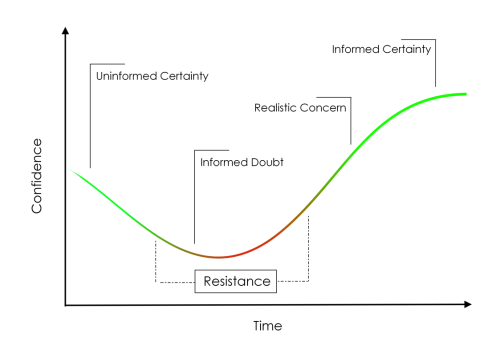By Elisabeth Goodman, 28th February 2019
I had a wonderful hour or so with members of CILIP’s K&IM community in a webinar yesterday evening on “Good Practices for Knowledge Sharing and Collaboration“. It was a taster of RiverRhee’s one-day course on this topic, which I have previously delivered through CILIP. The content is also well-documented in my book “The Effective Team’s Knowledge Management Workbook”.

Webinar given to CILIP’s Knowledge & Information Management SIG on 27th February 2019
The participants were a select few of about 30 practitioners. According to my poll at the start of the call, 38% were actively engaged in K&IM, 29% were starting to be involved, 24% were thinking about it, and 10% had other reasons to be on the call such as mentoring someone working in this field.
We had some very active discussions which provided insights on how this group are practising Knowledge Management, and what they might do as a result of what they learnt on the webinar. This blog summarises these insights.
Reasons for adopting a Knowledge Management strategy
I believe the reasons that Knowledge Management has continued to have traction since I first encountered it as a discipline in the 1990s, is that it can, and should, be closely aligned to an organisation’s goals and strategy.
I referenced the new ISO standard 30401 – Knowledge Management Systems – throughout the webinar, and, this is something that the standard also endorses:
“Knowledge management serves the organizational objectives, strategies and needs.” (0.3 Guiding principles f) Focus)
Prompted by my question, delegates gave some of their reasons for adopting a Knowledge Management strategy. These included:
- Maximising organisational assets
- Saving time for finding information/knowledge
- To get the right information to the right people at the right time
- To use previous learning and make processes etc more efficient
- Creating a strong link between the library and its users/organisation’s goals and needs
- Satisfying customers
- Promoting collaborative working
- To compensate for the person you’d want to ask being off work!
- Sharing ideas – more innovation
- Intelligent programming for maximised impact
- Sharing knowledge and a learning culture
Which tactics to use?
There are a number of tactics available for sharing knowledge between people and with the aid of technology. I focus on people-to-people tactics and gave a quick description of six of these as shown on this slide.
Participants on the webinar were already using some of these, and also expressed interest in trying out some that they were not using.
The methods some people were already using included:
- Ask the Expert
- Peer Assists,
- After Action Reviews
- Communities of Practice
The methods people indicated they would explore further included:
- Storytelling (you can read more about this in one of my previous blogs on storytelling)
- After Action Reviews
- Learning Reviews
Barriers and enablers for fostering knowledge sharing and collaboration
I advocate using simple tools such as SWOT (Strengths, Weaknesses, Opportunities, Threats) to understand what barriers and enablers are available to help you foster good practices in your organisation.
The ISO standard also advocates gaining an understanding of these barriers and enablers as illustrated by this slide.

We did a mini-exercise with the delegates on the webinar on what their barriers and enablers might be. These included:
Barriers:
- Other, higher, priorities in the organisation
- The difficulty of getting senior management attention
- KM being perceived as being too difficult or costly
- The diversity or incompleteness of current methods
- Experts might be reluctant
Enablers:
- People knowing that there is a need for KM
- Availability of allies in other departments
- The potential for increasing customer (student) satisfaction
Next steps for knowledge sharing and collaboration in your organisation?
The final conversation on the webinar was around what people might do to progress knowledge sharing and collaboration in their organisations.
Top of the list were to:
- Carry out a SWOT analysis with their teams
- Experiment with stories (maybe even horror stories illustrating the consequences of not having a KM strategy in place)
- Put more of an emphasis on building relationships rather than just focus on the technology
- Enlist management champions to lead by example
All in all it was a great conversation, and I look forward to more opportunities to continue it with this community. (The slides and recording from the presentation are available here – for CILIP members – if you are not a CILIP member and would like to know more about this, do get in touch.)
Notes
About the author. Elisabeth Goodman is the Owner and Principal Consultant at RiverRhee Consulting., a consultancy that specialises in “creating exceptional managers and teams”, with a focus on the Life Sciences. (We support our clients through courses, workshops and personal one-to-one coaching.) Elisabeth founded RiverRhee Consulting in 2009, and prior to that had 25+ years’ experience in the Pharmaceutical Industry in line management and internal training and consultancy roles supporting Information Management and other business teams on a global basis. RiverRhee is a member-to-member training provider for One Nucleus and a CPD provider for CILIP (Chartered Institute for Library and Information Professionals).
Elisabeth is accredited in Change Management, in Lean Sigma, in Belbin Team Roles, MBTI (Myers Briggs Type Indicator) and is an NLP (NeuroLinguistic Programming) Practitioner. She is a member of CILIP and of APM (Association for Project Management) in which she was a founding member of the Enabling Change SIG.















